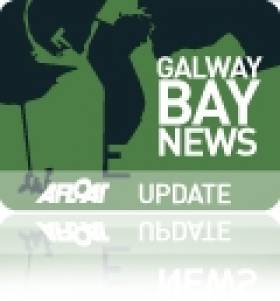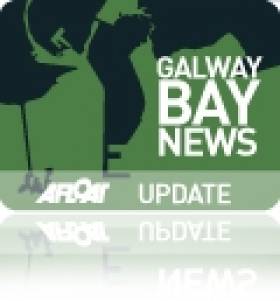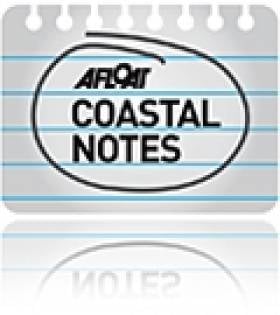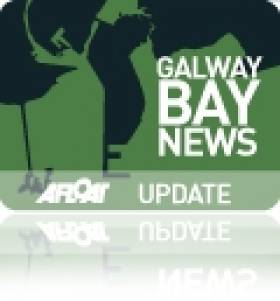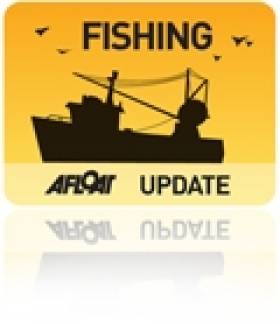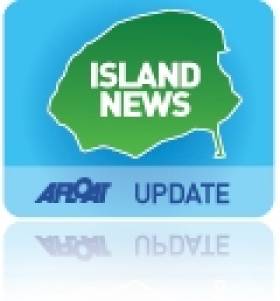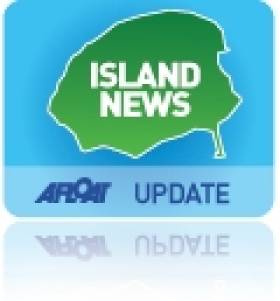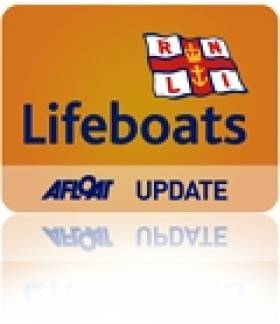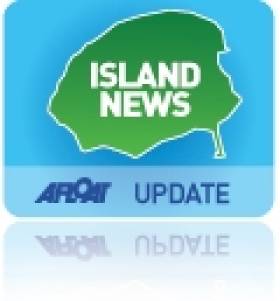Displaying items by tag: Aran Islands
BIM Brings Fish Farm Consultation to Aran Islands
#GALWAY FISH FARM - Galway Bay FM reports that a series of direct public consultations on the proposed Aran Islands fish farm in Galway Bay will begin this week.
Bord Iascaigh Mhara (BIM) is organising the meetings on the islands and in nearby Galway City to allow the public to view its proposals for what would be one of the largest aquaculture operations in Europe.
As previously reported on Afloat.ie, the public consultation period began last month for the 500-hectare organic fish farm to be located off Inis Oirr. BIM has applied for a deep sea salmon farming licence at the site some 6km off the island.
If approved, the operation could more than double Ireland's current farmed salmon production rate.
The scheme has faced opposition from local anglers and from Inland Fisheries Ireland, who claim it poses a risk to wild salmon stocks.
But BIM has condemned IFI's "stop everything" attitude regarding the fish farm proposals, while accusing environmental campaigners of being "deliberately alarmist", according to the Galway Independent.
Lobby group Friends of the Irish Environment entered a dispute with the sea fisheries board over the exclusion of an IFI report critical of the salmon farm from the statutory consultation.
“In the current climate, with jobs being as scarce as they are and economic development being the way it is, I think really that sort of attitude, that sort of museum curator ‘stop everything’ attitude is not good enough,” said BIM aquaculture development manager Donal Maguire.
Surfers, Islanders Clash at Doolin Pier Hearing
#COASTAL NOTES - Clare surfers say they have no confidence that development plans for Doolin Pier will not have a negative impact on the Crab Island surf break.
The Irish Examiner reports on an oral hearing on the project held by An Bord Pleanála in Ennistymon on Wednesday morning at which representatives of the Irish Surfing Association and the West Cost Surf Club expressed their fears of losing "the jewel in the crown" of Irish surfing.
As previously reported on Afloat.ie, local surfers have been at loggerheads with Clare County Council over long-delayed plans to redevelop the pier facilities at Doolin, which currently serves more than 70,000 passengers between the Clare coast and the Aran Islands.
At present the pier cannot be accessed at low tide, and foul weather cost the ferry route to 40 days's business last year, the meeting heard.
Island co-op Comhar Caomhán Inis Oírr is among the groups supporting the €8 million development plans, arguing that the islands would be "under threat" if the project does not proceed.
Campaigners In Dispute with BIM Over Galway Bay Fish Farm Report
#GALWAY FISH FARM - Environmental campaigners have retracted their accusation that Bord Iascaigh Mhara (BIM) suppressed a report critical of the proposed deep-sea fish farm in Galway Bay.
The Galway Independent reports on a statement released by lobby group Friends of the Irish Environment, which claimed that BIM tried to hide the study by not posting it on its website along with other materials made available for the public consultation period.
The report in question was commissioned by Inland Fisheries Ireland and is critical of the Environmental Impact Statements carried out on the proposed location for the 15,000-tonne organic salmon farm off the Aran Islands.
As previously reported on Afloat.ie, the salmon farm would be located on a 500-hectare site off Inis Oírr, and would be one of the largest of its kind in Europe, projected to be worth €103 million annually for the economy. The scheme has faced opposition from local anglers who fear it could have a negative impact on wild salmon numbers.
BIM strongly denied any wrongdoing, and the lobby group subsequently retracted its allegations upon learning that the IFI report had missed the deadline for submissions for the consultation.
“BIM certainly did not suppress or ignore or gloss over anything from IFI, because we never received anything," said a BIM spokesperson.
However, Friends of the Irish Environment now alleges that the IFI report was late due to a delay in their receipt of the Environmental Impact Statement from BIM.
The Galway Independent has more on the story HERE.
Surfers To Clash With Council Over Doolin Development
#DOOLIN PIER - The Irish Times reports that surfers will be at loggerheads with Clare County Council this week over controversial plans to redevelop Doolin Pier.
The €8 million plans for the Clare coastal village have been delayed for some time, and have already cost the council more than €250,000.
As previously reported on Afloat.ie, the development was backed unanimously by Clare councillors in March 2011 after revisions made following concerns from local surfers about its impact on popular waves in the area.
However, the Irish Surfing Association (ISA) maintained that even that revised plan would result in the elimination of the waves at Doolin Point and Crab Island - the latter described as Ireland's answer to the Pipeline in Hawaii.
The proposed new pier would serve the 70,000 passengers that use the ferry service between Doolin and the Aran Islands. The development is also supported by the Doolin unit of the Irish Coast Guard, which hopes to get a new coastguard station as part of development plans for the area.
Public Consultation on Galway Bay Fish Farm Set to Begin
#GALWAY FISH FARM - Galway Bay FM reports that a full public consultation on proposals for what's set to be Europe's largest fish farm off the Aran Islands is scheduled to begin next week.
As previously reported on Afloat.ie, the 15,000-tonne deep-sea organic salmon farm would be located on a 500-hectare site in Galway Bay off Inis Oírr, and would be one of the largest of its kind in Europe, projected to be worth €103 million annually for the economy.
The statutory consultation period ended earlier this month after delays over the summer in publishing the licence application. And from next Monday 15 October, Bord Iascaigh Mhara (BIM) will make the plan and all statutory feedback available to the public via its website at www.bim.ie.
Advertisements announcing the consultation will appear in local and national newspapers, and packs will also be available to view for locals at Kilronan and Salthill Garda stations, including copies of the environmental impact statements and information on the statutory consultation process.
BIM aquaculture development manager Donal Maguire told Galway Bay FM that transparency is key to ensuring the public had all the information they need regarding the scheme - which has faced opposition from local anglers who fear the fish farm could have a negative impact on wild salmon numbers.
Statutory Consultation Underway for Galway Bay Salmon Farm Licence
#FISHING - Bord Iascaigh Mhara (BIM) has begun the process of statutory consultation as the next step in its licence application for the controversial proposed deep-sea fish farm in Galway Bay.
As previously reported on Afloat.ie at the end of June, Ireland's fisheries board had announced a "significant delay" of four to six weeks before publishing the licence application.
But in a recent statement, BIM announced that it received permission some weeks ago from the Department of Agriculture, Food and the marine to begin the statutory consultation process, in which it is sharing the licence application and Environmental Impact Statement "with a list of State bodies for their appraisal and feedback".
The statutory consultation will continue till Tuesday 2 October 2012, and BIM promises that all feedback will be made available to the public via the BIM website "to further assist them in their assessment of the Environmental Impact Statement when it goes to full public consultation".
The 15,000-tonne organic salmon farm would be located off Inis Oírr in the Aran Islands on a 500-hectare site, and would be one of the largest of its kind in Europe, projected to be worth €103 million annually for the economy.
BIM intends to franchise the licence, should it be approved, to a third party "who agrees to a legally binding contract to farm the Atlantic salmon to the highest organic and environmental standards". Approval of the project could also see the creation of as many as 500 jobs, some 20% more than previously estimated.
The news comes after the ministerial apprival of salmon farm licence assignments from five separate operators in nearby Connemara, designed to "consolidate and revitalise" aquaculture in the region.
But the Aran Islands scheme has faced opposition from local anglers who fear that the fish farm could have a detrimental effect on wild salmon numbers.
Explaining BIM's plans for the consultation process, the statement added: "Previously, both statutory and public consultation would have been carried out in parallel. However, Ireland has recently (June 2012) ratified the Aarhus Convention. The convention lays down rules to promote citizens involvement and to improve public consultation in the making of decisions with potential environmental impact by the state.
"Given the recent ratification of the Convention and for a number of other legal and technical reasons, the Minister for Agriculture, Food and the Marine, Simon Coveney TD, has signed a new Statutory Instrument (SI No 301 of 2012), bringing into law new periods of public consultation for fish farm licence applications. In this instance the Department of Agriculture, Food and the Marine have instructed BIM to carry out statutory consultation in full before proceeding with public consultation.
"BIM believes that this approach will help to further inform the public during their period of consultation."
Russian Wows Aran Islands Crowds at Red Bull Cliff Diving Event
#CLIFF DIVING - Russian cliff diver Artem Silchenko wowed the crowds on Inis Mor at the weekend, scoring big with a "breathtaking" new dive to take his second victory in a row in the Red Bull Cliff Diving World Series.
As the Irish Independent reports, 700 lucky spectators who won tickets to the limited-capacity event in the Aran Islands saw the 28-year-old steal the thunder from veteran diver Orlando Duque on a weekend that witnessed some spectacular 28-metre dives at Poll na Peist.
"My armstand with blind entry was brilliant and I beat by Orlando by just four points," Silchenko told Red Bull after his victory, which came just two weeks after he topped Duque to claim his first win of the series in the Azores.
"When I came to the platform after Orlando dived I saw nine and nine-and-a-halfs from the judges but I knew what I had to do for my final dive [a back triple triple].
"You know it’s a good dive only when you’re underwater. You’re travelling so fast it’s impossible to take it all in. Only after the entry can you say 'yes, it’s a great dive.'"
Silchenko had to pull out all the stops with Duque putting together his best set of dives all year. And the Colombian, whose programme included a back triple triple and his trademark reverse twister, says it bodes well for the rest of the season.
"This was probably the best competition I’ve done this year," said Duque. "It’s a challenge the way Artem is performing but I’m also doing better.
"This was my highest score of the season. If I can keep up this level then it’s going to be difficult for the others."
Nine-time world champion Duque retains the lead of the overall ranking going into the second half of the 2012 series, which next heads to Boston at the end of August.
#RED BULL CLIFF DIVING - Red Bull will publicise the risks involved with cliff diving in an effort to avoid copycat attempts by the public after its event on Inis Mór next month, said a spokesperson.
As previously reported on Afloat.ie, the Red Bull Cliff Diving World Series will make a stop in the Aran Islands on the weekend of 3-4 August, where the world's best cliff divers will converge for the season's halfway stage.
However, fears have been raised by the islands' GP after copycat attempts at a similar event in 2009 resulted in a number of serious injuries.
Video footage of that event posted on YouTube was blamed for inspiring untrained people to cliff dive with no safety or rescue personnel present. In one case this resulted in a "very serious" spinal injury, said Dr Marion Broderick.
Of particular concern is the location of the diving site at the Serpent’s Lair – ‘Poll na Peist’ in Irish – which is in an area with poor mobile phone reception, a situation compounded by the GP's lack of a handheld VHF radio.
The Irish Times has much more on the story HERE.
Lifeboats Old and New Meet on the Aran Islands
#RNLI – A surprise return visit to the Aran Islands was made recently by former Galway Bay RNLI lifeboat Frank Spiller Locke. This restored Barnett class lifeboat was stationed at the Aran Islands from 1977 to 1985. She was previously stationed at Weymouth on the south coast of England. During her years of lifeboat service she was launched 396 times and saved 181 lives.
The lifeboat was funded through a legacy from Dr. Frank Spiller Locke. RNLI records show that his widow Mrs E. F. Locke took a strong interest in the work of the lifeboat and her volunteer crew and asked for the returns of service for every callout to be sent to her until her death.
The vessel was built in Cowes during 1958 at a cost of £38,500. It was a Barnett class lifeboat, which was introduced into the RNLI in 1950. Twenty of these 52 ft lifeboats were built by the charity. The institution retired and sold this lifeboat in 1986 and she was rescued sometime later by Colin and Janet Sturmer who are from the Isles of Scilly. They dedicated ten years to restoring this boat to its original form.
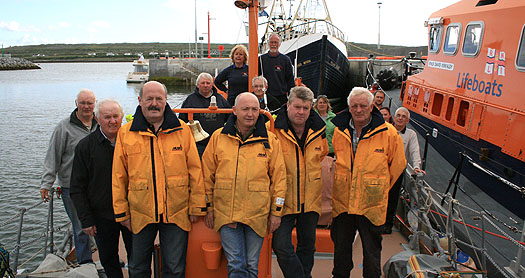
Pictured on the deck of the former Galway Bay lifeboat in yellow jackets are members of the current Aran Islands RNLI crew who also served on the Frank Spiller Locke lifeboat (L-R) Mairtin Fitz, Micheal O Goill, Johnny Mulkerrin, Enda Mullen.
"It was a lovely surprise to see this lifeboat in the Bay where she used to anchor in the 1980s" said Micheal Heron Aran Islands RNLI Lifeboat Operations Manager.
The two lifeboats, retired and current were moored side by side so that past and present crew could look over it. Four of the current lifeboat crew who served on the Frank Spiller Locke, Mairtin Fitzpatrick, Michéal Ó Goill, Johnny Mulkerrin and Enda Mullen, were joined by retired crewmembers Paddy Mullen, Bartley Mullen (Coxswain/Mechanic), Jackie Gill and Tomas Kelly. Many local people also came for a look and remembered stories of times that they or their families needed this lifeboat
Commenting on the visit, serving crewmember Micheal Gill added "there are a lot of differences in the speed and technology of these older boats. She served the west coast well at a time when there were only three lifeboats from Donegal to South Kerry and no helicopters.
This boat is a valuable piece of our maritime heritage, which has been lovingly restored bye Colin and Janet. Hopefully it will visit the west coast again in the future."
Man Dies After Ferry Fall in Aran Islands
#ISLAND NEWS - A 73-year-old man has died after a fall on a ferry in the Aran Islands at the weekend.
The Irish Times reports that the man, named locally as James McClean, sustained serious head injuries when he fell in a stairwell on the ferry, which was heading to dock at Kilronan Harbour on Inish Mór, on Sunday morning.
According to TheJournal.ie, the man is believed to have been working on the vessel Ceoil na Farraige at the time. He was airlifted by the Irish Coast Guard to Galway University Hospital in serious condition but later died as a result of his injuries.


























